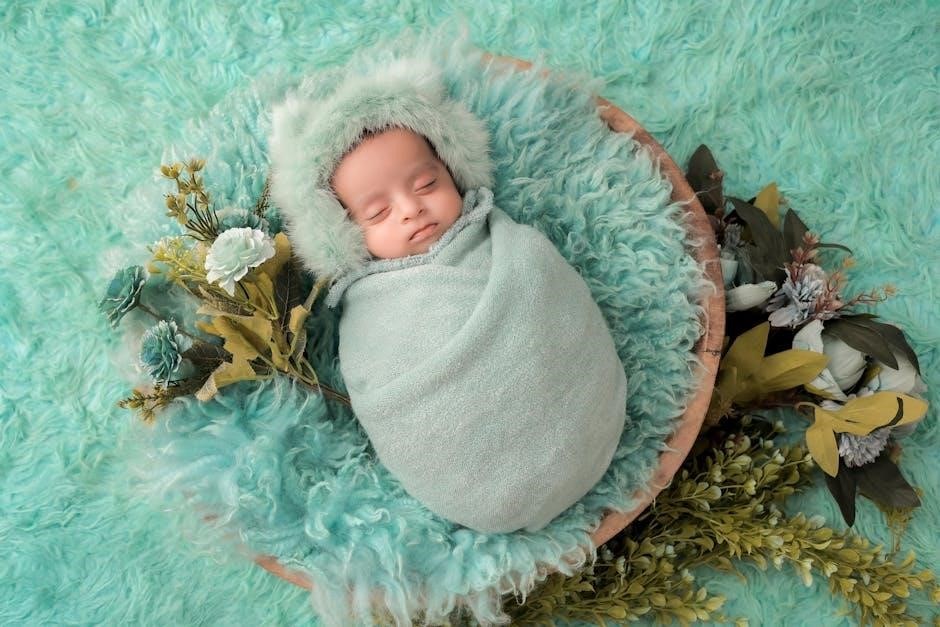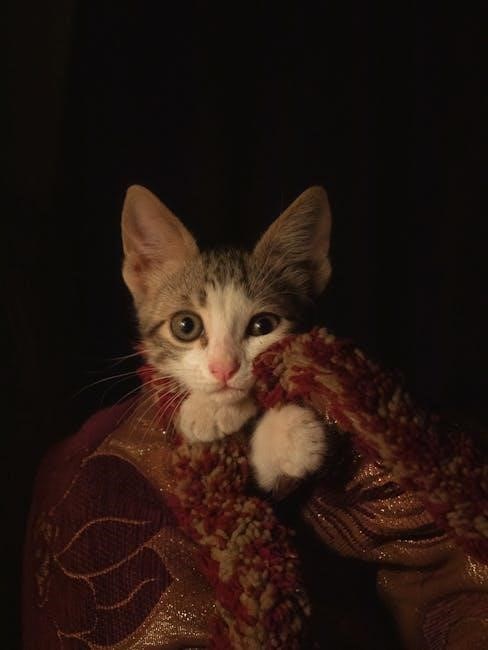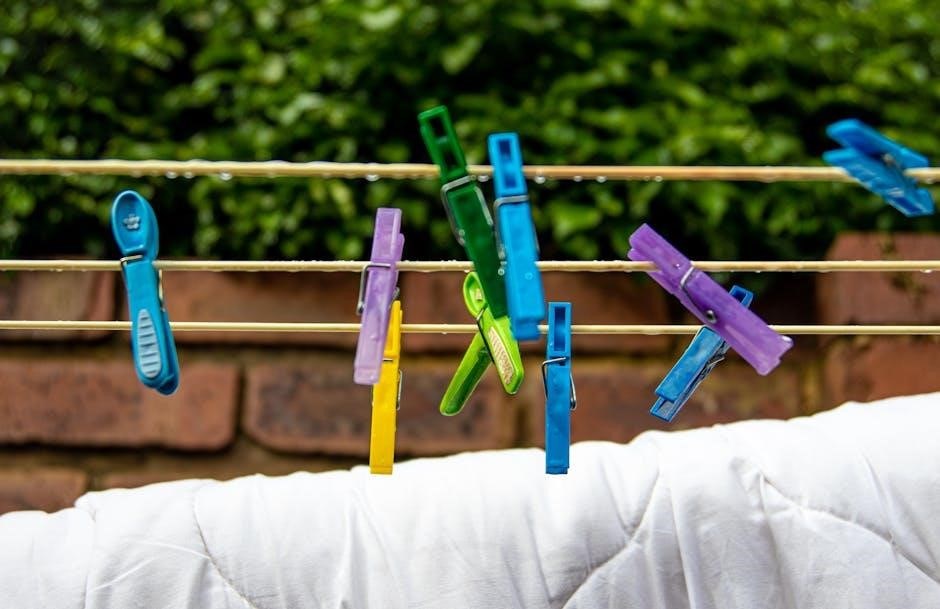Minky blankets are luxurious‚ soft‚ and cozy‚ requiring special care. Proper washing ensures they stay plush and vibrant. Wash alone in cold water‚ avoid harsh detergents‚ and skip fabric softeners for optimal results. Follow these steps to maintain their softness and extend their lifespan.
Understanding Minky Fabric
Minky fabric is a soft‚ luxurious‚ and plush material often used in blankets and crafts. It is typically made from synthetic fibers like polyester‚ known for its velvety texture and vibrant colors. The fabric features a thick‚ dense pile that gives it a cozy feel. Minky fabric is popular for baby blankets and home decor due to its warmth and aesthetic appeal. However‚ it requires gentle care to maintain its softness and texture. Improper washing or harsh chemicals can damage the fibers‚ making the fabric less plush over time. Understanding its composition helps in applying the right washing techniques to preserve its quality.
Importance of Proper Washing Techniques
Proper washing techniques are crucial to maintain the softness‚ texture‚ and vibrancy of minky fabric. Improper washing can lead to damage‚ such as pilling‚ fuzziness‚ or color fading. Using harsh detergents or fabric softeners can leave residues that dull the fabric and reduce its plush feel. Additionally‚ high heat or aggressive washing settings can shrink or distort the material. By following the right washing methods‚ you can preserve the quality and extend the lifespan of your minky blanket. Regular‚ gentle care ensures it remains cozy and visually appealing for years to come‚ making it a worthwhile investment for home comfort and style.
Overview of Washing Process
The washing process for minky blankets involves several key steps to ensure they remain soft and intact. Start by checking the care label for specific instructions. Sort and wash the blanket separately to prevent damage from other fabrics. Pre-treat any stains gently before washing. Use cold water and a mild detergent‚ avoiding fabric softeners. Opt for a gentle cycle or hand wash for delicate fabrics; Rinse thoroughly to remove all detergent residue. For drying‚ air drying is recommended‚ but if using a dryer‚ ensure it’s on a no-heat setting. Proper washing and drying techniques preserve the blanket’s softness and texture‚ ensuring long-term comfort and durability.

Pre-Washing Preparation
Before washing‚ inspect the minky blanket for stains and loose threads. Remove any loose debris gently. Check the care label for specific washing instructions. Ensure the blanket is washed alone to prevent snagging or damage from other fabrics. Pre-treat any stains with a mild detergent or vinegar solution. Avoid using fabric softeners‚ as they can reduce the blanket’s softness over time. Using cold water and a gentle detergent is crucial for maintaining the minky fabric’s texture and color. Proper preparation ensures the blanket remains soft‚ vibrant‚ and intact after washing.
Checking Care Labels
Always check the care label on your minky blanket for specific washing instructions. Each blanket may have unique requirements‚ even if general guidelines suggest cold water and mild detergents. Ignoring the label can lead to damage‚ shrinkage‚ or color fading. Look for recommended water temperature‚ detergent type‚ and any special instructions. Some labels may advise against fabric softeners or bleach. Pay attention to symbols indicating machine or hand washing preferences. Following the manufacturer’s guidelines ensures the blanket retains its softness‚ texture‚ and vibrancy. Proper care starts with understanding the specific needs of your minky blanket‚ as outlined on its care label.
Sorting and Washing Alone
Sort minky blankets separately from other laundry to prevent damage. Washing them alone ensures they aren’t snagged or stretched by heavier items. Minky fabric can shed lint or pills if mixed with rough textures. Use a mesh laundry bag for added protection. Avoid overloading the washing machine‚ as this can cause friction and lead to pilling. Washing alone also prevents cross-color bleeding‚ especially for vibrant or dark-colored blankets. This step ensures a gentle cleaning process tailored specifically to the delicate minky fabric‚ preserving its softness and texture throughout the wash cycle.

Pre-Treatment of Stains
Before washing‚ inspect the minky blanket for stains. Gently blot any spots with a clean‚ damp cloth to remove excess residue. Avoid rubbing‚ as it may damage the fabric. For stubborn stains‚ apply a small amount of mild detergent directly to the area. Let it sit for 10-15 minutes to allow the detergent to penetrate. Do not use harsh chemicals or abrasive cleaners‚ as they can harm the minky fabric. After pre-treatment‚ proceed with washing on a gentle cycle. Always test a small‚ inconspicuous area first to ensure the detergent doesn’t cause discoloration or damage.
Using Cold Water
Always wash minky blankets in cold water to preserve their softness and texture. Hot water can cause the fibers to shrink or become misshapen‚ ruining the blanket’s plush feel. Cold water gently cleans without damaging the fabric‚ ensuring the minky retains its loft and vibrancy. It also prevents colors from fading and reduces the risk of pilling. For best results‚ use a gentle cycle with cold water and avoid soaking the blanket for extended periods. This method maintains the blanket’s quality and keeps it looking new for years to come.

Choosing the Right Detergent
Selecting the right detergent is crucial for maintaining minky fabric. Use mild‚ eco-friendly detergents without harsh chemicals or fabric softeners. Avoid overly fragranced options to preserve softness and prevent damage.
Mild Detergents for Minky Fabric
Choose mild detergents specifically designed for delicate or luxury fabrics. Avoid harsh chemicals‚ as they can strip minky fabric of its softness. Opt for fragrance-free or hypoallergenic options to prevent irritation and maintain the blanket’s texture. Some detergents are labeled as “minky-safe‚” making them ideal choices. Always check the ingredient list to ensure no fabric softeners or bleach are present‚ as these can damage the fibers; Using the right detergent helps preserve the blanket’s plush feel and vibrant colors‚ ensuring it remains cozy and beautiful for years.
Eco-Friendly Detergent Options
Eco-friendly detergents are a great choice for washing minky blankets‚ as they minimize environmental impact without compromising on cleanliness. Look for plant-based‚ biodegradable detergents free from phosphates and chlorine. These options are gentle on the fabric and prevent damage to the soft minky texture. Some eco-friendly detergents are specifically designed for delicate or luxury fabrics‚ ensuring they clean effectively while preserving the blanket’s softness. Using eco-friendly products also helps maintain the blanket’s vibrant colors and prevents fading. This sustainable approach ensures your minky blanket stays pristine while promoting a greener laundry routine.
Avoiding Fabric Softeners
Fabric softeners should never be used when washing minky blankets. These products leave a residue on the fabric‚ which can damage the soft‚ plush texture of the minky material. Over time‚ this residue can cause the blanket to feel stiff or lose its luxurious feel. Additionally‚ fabric softeners can trap odors between the fibers‚ making it harder to eliminate smells completely. Using fabric softeners can also reduce the blanket’s ability to absorb water‚ leading to less effective washing. To maintain the softness and integrity of your minky blanket‚ it’s best to avoid fabric softeners entirely during the washing process.
Using Vinegar as an Alternative
Vinegar is a natural and effective alternative to fabric softeners for washing minky blankets. Adding a small amount of white vinegar to the rinse cycle helps remove any residual detergent and odors without leaving a harmful residue. Vinegar gently balances the pH of the fabric‚ preserving the softness and preventing the buildup of chemicals. It also helps maintain the blanket’s breathability and freshness. For best results‚ use half a cup of vinegar in the rinse water. This method is eco-friendly and ensures the minky fabric remains soft‚ clean‚ and free from unwanted odors without damaging the material over time.

Washing Methods
Minky blankets can be washed using a machine on a gentle cycle or by hand. Avoid aggressive settings to protect the fabric and maintain its softness.
Machine Washing on Gentle Cycle
Machine washing Minky blankets on a gentle cycle is effective. Place the blanket in a mesh laundry bag for protection. Use cold water to prevent shrinking or damage. Choose a mild detergent without fabric softeners or harsh chemicals. Avoid overloading the washer to ensure gentle agitation. After the cycle‚ promptly remove the blanket to prevent creasing. Do not wring or twist‚ as this can stretch the fabric. For optimal results‚ air dry or tumble dry on a no-heat setting. This method maintains the blanket’s softness and texture while ensuring a clean finish.
Hand Washing for Delicate Blankets
Hand washing is ideal for delicate Minky blankets. Fill a basin with cold water and add a small amount of mild detergent. Gently agitate the water to create a soft lather. Submerge the blanket‚ working the soap into the fabric with your hands using light‚ even strokes. Avoid scrubbing or wringing‚ as this can damage the fibers. Rinse thoroughly by submerging the blanket in clean‚ cold water until no soap remains. Gently squeeze out excess water without twisting. Do not use fabric softeners‚ as they can reduce softness. Lay the blanket flat or hang to air dry‚ ensuring even drying.
Avoiding Aggressive Washing Settings
Avoid using aggressive washing settings‚ such as hot water or heavy-duty cycles‚ as they can damage Minky fabric. Heat can cause the fibers to shrink or lose their softness‚ while intense agitation may lead to pilling or fraying. Always opt for a gentle cycle with cold water to preserve the blanket’s texture. Avoid using fabric softeners or harsh detergents‚ as they can leave residues that dull the fabric. If hand washing‚ avoid scrubbing or wringing‚ as this can harm the delicate fibers. Gentle care ensures the blanket retains its luxurious feel and appearance for years to come.
Importance of Gentle Agitation
Gentle agitation is crucial when washing Minky blankets to prevent damage. Harsh movements can cause friction‚ leading to pilling or fraying of the soft fabric. Use a washing machine with a delicate cycle or hand wash using light‚ swishing motions to clean the blanket without stressing the fibers. Avoid wringing or twisting‚ as these actions can stretch or break the material. Gentle agitation ensures the Minky fabric remains smooth and intact‚ preserving its softness and texture. This careful approach extends the blanket’s lifespan and maintains its luxurious quality for continued comfort and enjoyment.

Drying Methods
Air drying is recommended for Minky blankets to preserve softness. Use a tumble dryer on no heat or air fluff setting if necessary. Avoid direct sunlight exposure to prevent fading. Fluff the blanket after drying to restore loft and texture‚ ensuring it remains plush and cozy for long-lasting comfort.
Air Drying for Best Results
Air drying is the most recommended method for Minky blankets to maintain their softness and texture. Lay the blanket flat on a clean‚ dry surface or hang it over a sturdy clothesline‚ reshaping it to its original dimensions. Avoid direct sunlight‚ as it can cause fading. Gently pat excess moisture with a clean towel before air drying. Ensure good airflow to prevent musty odors. This method preserves the blanket’s plushness and prevents shrinkage or damage from heat. Allow it to dry completely‚ which may take several hours‚ depending on thickness and ambient conditions. This ensures the blanket remains cozy and vibrant for years.
Using a Tumble Dryer on No Heat
If air drying isn’t convenient‚ a tumble dryer on a no-heat setting is the next best option. Place the Minky blanket in the dryer alone to prevent friction damage. Use a low-tumble or delicate cycle to minimize agitation. Remove the blanket while it’s still slightly damp to avoid pilling or fuzziness. Lay it flat on a clean‚ dry surface to air dry completely. This method is faster than air drying while still protecting the fabric. Ensure no fabric softener or heat is used‚ as these can damage the fibers. This approach maintains softness and texture‚ keeping your blanket cozy and vibrant for years.
Avoiding Direct Sunlight
Avoid exposing your Minky blanket to direct sunlight‚ as it can cause fading and discoloration. Sunlight may also dry out the fabric‚ leading to a rough texture. Instead‚ opt for shaded areas or indoor drying to preserve the softness and vibrancy of the material. If you must dry outside‚ choose a covered spot or use a UV-protective cover. Direct sunlight can weaken the fibers over time‚ reducing the blanket’s longevity. By keeping it out of direct sun‚ you ensure the colors stay rich and the fabric remains plush for years to come. This simple care step is essential for maintaining your Minky blanket’s quality.
Fluffing the Blanket After Drying
Fluffing your Minky blanket after drying is crucial to restore its softness and loft. Gently shake the blanket or use your hands to fluff it‚ especially if it was machine dried on a low setting. This step helps redistribute the fibers‚ preventing them from matting together. For best results‚ fluff the blanket while it is still slightly damp‚ as this allows the fibers to relax and return to their natural texture. Regular fluffing ensures the blanket remains plush and cozy. Avoid vigorous shaking‚ as it may damage the fabric. Instead‚ handle it gently to maintain its luxurious feel and appearance.

Maintenance and Care
Regular maintenance ensures Minky blankets retain their softness and texture. Brushing‚ proper storage‚ and a consistent cleaning schedule are key to preserving their luxurious feel and appearance over time.
Brushing Minky Fabric
Brushing Minky fabric is essential for maintaining its softness and texture. Use a soft-bristle brush or a velvet brush to gently remove loose fibers and prevent pilling. Brushing helps restore the fabric’s natural loft and ensures it remains plush. For best results‚ brush the blanket before washing to prevent fuzziness and after drying to restore its texture. Regular brushing also prevents snagging and keeps the fabric looking new. Avoid using harsh brushes‚ as they may damage the delicate fibers. Brushing is a simple yet effective way to preserve the luxurious feel of your Minky blanket and extend its lifespan.
Storage Tips for Minky Blankets
To maintain the quality of Minky blankets during storage‚ use a breathable fabric bag or a cotton storage bag. Avoid plastic bags‚ as they can trap moisture and cause mildew. Store the blanket in a cool‚ dry place away from direct sunlight to prevent fading. Do not fold the blanket for extended periods‚ as this may cause creases or stretching. If folding is necessary‚ periodically refold it to avoid permanent lines. Clean the blanket before storing to prevent stains from setting in. Consider adding a cedar chip sachet to repel pests naturally. Proper storage preserves softness and texture for long-term enjoyment.
Regular Cleaning Schedule
For minky blankets‚ a regular cleaning schedule helps maintain their softness and appearance. Wash them every 3-4 months or when visibly soiled. Spot clean spills immediately to prevent stains. Avoid over-washing‚ as it can degrade the fabric. Use a gentle detergent and cold water for machine washing. Air drying is recommended to preserve texture. Between washes‚ shake the blanket outdoors to remove loose debris. Brushing the fabric gently can help restore its plushness. Store the blanket in a breathable bag when not in use to prevent moisture buildup. Regular maintenance ensures the blanket remains cozy and vibrant for years.
Preserving Softness and Texture
To preserve the softness and texture of minky blankets‚ avoid using fabric softeners and harsh detergents‚ as they can leave residues. Wash in cold water on a gentle cycle and air dry to prevent fiber damage. Brushing the fabric with a soft-bristle brush after washing can restore its plushness. Avoid direct sunlight‚ as it may cause fading or stiffening. Store the blanket in a cool‚ dry place‚ preferably in a breathable bag. By following these care tips‚ your minky blanket will retain its luxurious feel and remain a cozy favorite for years to come.

Troubleshooting Common Issues
Common issues like pilling‚ odors‚ or color fading can be addressed by gentle washing‚ vinegar treatments‚ and avoiding direct sunlight. Regular care ensures longevity and softness.
Removing Odors from Minky Blankets

Odors on minky blankets can be effectively removed by washing them in cold water with a mild detergent. Adding a 1/2 cup of white vinegar during the rinse cycle helps neutralize smells without damaging the fabric. Avoid using fabric softeners‚ as they can trap odors and reduce the blanket’s softness. For stubborn odors‚ pre-treat the area with a mixture of equal parts water and vinegar before washing. Air drying is recommended to prevent musty smells from developing. Regular cleaning and proper drying will keep your minky blanket fresh and odor-free.
Fixing Pilling or Fuzziness
Minky fabric can develop pilling or fuzziness over time due to friction during washing. To address this‚ use a front-loading washing machine or a gentle cycle to minimize agitation. Avoid fabric softeners‚ as they can leave residues that exacerbate pilling. For existing pills‚ gently use a fabric shaver or a disposable razor specifically designed for fabrics‚ taking care not to damage the minky fibers. Brushing the blanket with a soft-bristle brush can also help restore its texture and reduce fuzziness. Air drying is recommended to prevent further damage from heat. Using mild detergents and avoiding vinegar can help maintain the fabric’s integrity and prevent pilling.
Preventing Color Fading
To prevent color fading on your minky blanket‚ wash it in cold water using a mild detergent free of bleach or brighteners. Avoid using fabric softeners‚ as they can dull colors. Turn the blanket inside out before washing to protect the outer layer from friction. Air drying is recommended‚ as heat from dryers can cause colors to bleed. If using a dryer‚ ensure it’s on a no-heat setting. Avoid exposing the blanket to direct sunlight‚ as UV rays can fade colors. Washing the blanket separately from other laundry can also prevent dye transfer and maintain its vibrant appearance over time.
Restoring Loft and Softness
To restore the loft and softness of your minky blanket‚ avoid using fabric softeners‚ as they leave a residue that flattens fibers. Instead‚ add a small amount of white vinegar during the rinse cycle to naturally soften and remove any buildup. Wash the blanket in cold water on a gentle cycle to prevent damage. After washing‚ gently shake the blanket to redistribute the fibers. Air drying is best‚ as heat from dryers can flatten the material. Avoid direct sunlight‚ as it can cause fading and stiffness. Regular‚ gentle washing and proper drying will help maintain the blanket’s plush texture and loft.

Eco-Friendly Washing Tips
Opt for energy-efficient washing machines and natural drying methods like air drying or line drying. Use eco-friendly detergents and minimize chemical use to protect the environment and fabric.
Energy-Efficient Washing Practices
To maintain energy efficiency while washing minky blankets‚ use cold water and a gentle cycle. Avoid hot water‚ as it consumes more energy and can damage the fabric. Choose eco-friendly detergents that are designed for low-energy washing. Front-loading washing machines are more energy-efficient than top-loading ones. Additionally‚ skip fabric softeners‚ as they can harm the minky fabric and reduce the need for repeated washing. Consider using vinegar as a natural alternative to maintain freshness without chemical additives. By adopting these practices‚ you can reduce your environmental impact while preserving the softness and quality of your minky blanket.
Using Natural Drying Methods
Air drying is the best method for preserving minky blankets. Lay the blanket flat on a clean‚ dry surface or hang it over a sturdy clothesline. Ensure it dries in a shaded area to prevent direct sunlight from fading colors. Avoid using tumble dryers with heat‚ as they can damage the fabric. If you must use a dryer‚ select the no-heat or air-fluff setting. Natural drying prevents shrinkage and maintains the blanket’s softness. Regularly fluff the blanket during drying to restore its loft. This eco-friendly approach ensures your minky blanket remains plush and vibrant for years to come.
Reducing Chemical Use
To maintain minky blankets sustainably‚ minimize chemical use. Opt for mild‚ eco-friendly detergents free from harsh additives. Avoid fabric softeners‚ as they leave residues that reduce softness. Instead‚ add a half-cup of white vinegar during the rinse cycle to naturally soften the fabric and eliminate odors. Vinegar also helps remove detergent residue without harming the minky fibers. By reducing chemical exposure‚ you preserve the blanket’s texture and color. Eco-conscious practices not only benefit the environment but also extend the life of your minky blanket‚ keeping it soft and luxurious for years to come.
Sustainable Fabric Care
Sustainable fabric care for minky blankets involves eco-friendly practices. Use mild‚ biodegradable detergents to minimize environmental impact. Avoid fabric softeners and opt for vinegar rinses instead. Air drying or tumble drying without heat preserves fibers and reduces energy use. Regular brushing maintains softness naturally. Store blankets in breathable bags to prevent moisture buildup; By adopting these methods‚ you extend the blanket’s life and reduce your ecological footprint. Sustainable care ensures your minky blanket remains soft and vibrant while promoting environmentally responsible practices.
Proper care ensures your minky blanket remains soft and vibrant. Wash alone in cold water‚ avoid fabric softeners‚ and air dry for long-lasting comfort and sustainability.
- Always wash minky blankets separately to prevent damage and pilling.
- Use cold water and a gentle cycle to maintain softness and texture.
- Choose a mild detergent without fabric softeners or harsh chemicals.
- Avoid using fabric softeners‚ as they can trap between fibers.
- Pre-treat stains gently before washing to ensure effective removal.
- Air drying is recommended for best results; tumble dry on no heat if necessary.
- Brush the blanket periodically to restore loft and softness.
- Store minky blankets in a cool‚ dry place to prevent fading and damage.
Long-Term Benefits of Proper Care
Proper care ensures minky blankets retain their softness‚ texture‚ and vibrant colors. Regular gentle washing prevents pilling and fuzziness‚ while avoiding fabric softeners maintains breathability. Air drying and brushing restore loft and prevent damage‚ ensuring the blanket remains cozy and luxurious. Storing in a cool‚ dry place prevents fading and extends lifespan. These practices not only preserve the blanket’s appearance but also ensure it remains a comfortable‚ durable favorite for years‚ offering long-term value and enjoyment.
Final Tips for Maintaining Minky Blankets
Regular brushing and gentle washing are key to maintaining minky blankets. Avoid fabric softeners and harsh detergents to preserve softness. Air drying prevents shrinkage and damage. Store in a cool‚ dry place to maintain texture and color. For odors‚ vinegar rinse helps without chemicals. Brushing restores loft and reduces pilling. Wash alone to prevent snagging. Following these tips ensures your minky blanket stays soft‚ vibrant‚ and luxurious for years. Proper care not only extends lifespan but also keeps it cozy and comfortable‚ making it a timeless favorite in your home.